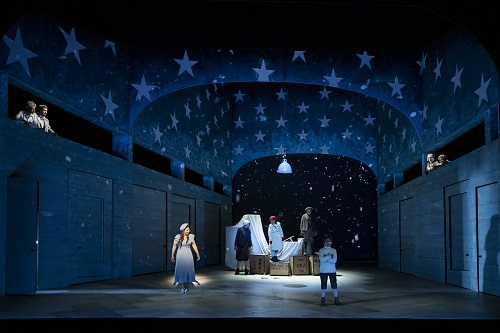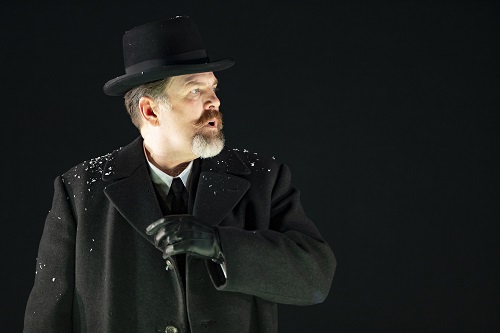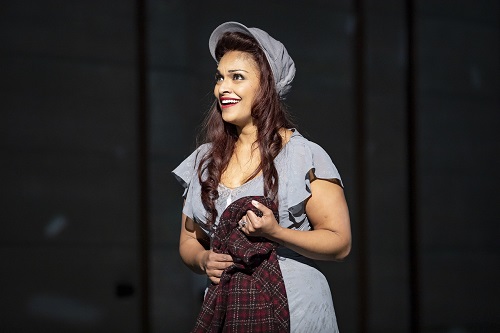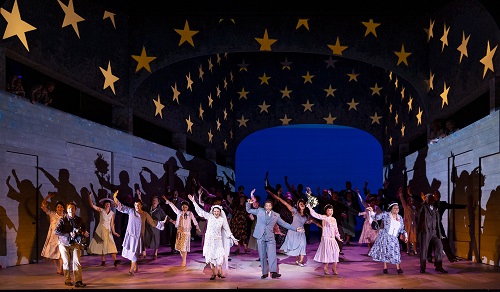For want of a mislaid £8000, both George Bailey’s company and his own reputation are on the brink of ruin, and he himself stands on a literal precipice, ready to jump to his death. For want of its withdrawn Arts Council grant, with its funding slashed to zero English National Opera faces eviction from its London home and stands on the brink of extinction.
In Frank Capra’s 1946 movie, It’s a Wonderful Life, the good people of folksy Bedford Falls in upstate New York dip into their pockets and find both money and love for George, whose epiphanic restoration – “I want to live again!” – is prompted by a strange old chap, Clarence Oddbody, an ‘Angel, second-class’, who shows him what life in the small town would have been like had he never been born. George’s friends and family toast him as “the richest man in town!” How ENO must be praying for friends with deep pockets – or at least those prepared to fight a rescue campaign – and for an angel, of any class, to show that, like George’s acts of compassion and kindness, opera too touches lives and brings goodness into the world.

Many will write, I’m sure, of the ironies of ENO’s programming of Jake Heggie’s 2016 opera based on Capra’s feel-good movie as a Christmas crowd-pleaser – not least because Capra’s apparent affirmation of democracy is in fact tempered by darkness and disillusionment. George might dream of travelling to far-off lands, but he’s chained to Bedford Falls by his responsibilities to his childhood sweetheart, Mary, and their three children, as well as to the dull desk-job which he loathes at his late father’s Bailey Bros. Building and Loan company – a business which spares the townsfolk from exploitation by the rapacious millionaire banker and property developer, Henry F. Potter.
It’s a Wonderful Life is dominated by themes of poverty, death and suicide. Bedford Falls represents a reactionary and illusory idealisation of small-town Americana. And, a messiah has not yet appeared to solve the housing crisis or rid the ruling class of racists, narcissists and plutocrats. Those young audiences whom ENO does so much to develop and encourage would surely shrug their shoulders at the notion, espoused by George’s father that, “It’s deep in the race for a man to want his own roof and walls and fireplace”.

Heggie and his librettist, Gene Scheer, overlook Capra’s darker insights. If cheesy schmaltz, with a heavenly host of twinkling, winking stars gazing down benevolently, is your cup of tea, then you’ll find this production wonderful indeed. Designer Giles Cadle crowns the set with a celestial dome, and a quartet of silvery angels (Keri Fuge and ENO Harewood artists Idunnu Münch, Zwakele Tshabalala and Ossian Huskinson) look on from a gallery, determining George’s, and the second-class angel Clara’s, fate. There are airborne antics – somewhat clumsy on first night – and a glitzy opening scene of sparkling snow and stars. The various locales are economically gestured. One can’t fault the company’s slick presentation of Scheer’s twenty scenes which are deftly directed and choreographed by Aletta Collins. Conductor Nicole Paiement is no less committed in the pit, drawing super, vibrant playing from the ENO musicians.
But, Scheer’s libretto, which sticks closely to the filmscript, is mired down with verbose bankers’ talk of debts and dues, and repetitive reminders of George’s ambitions to see the Pathernon and Colosseum, and travel to Fiji to dance the Mekee-Mekee. Cries of “George”, “Mary” fly back and forth ad infinitum. And, when the shifts of dramatic tone arrive at the close the gears crunch teeth-gratingly. Heggie’s anodyne score simply doesn’t connect with the characters and their experiences. No matter of what miseries they sing, a bland, saccharine melodism prevails – without a single ‘melody’ ever making a mark. You’ll spot a few Christmas carols interweaved into the note-spinning, though, and be invited to join the cast in a hearty rendition of Auld Lang Syne at the close.

It’s telling that at the dramatic climax, the music stops. In the movie, Capra used a freeze-frame in the fantasy sequence in which an unseen character, Joseph, narrates George’s life to Clarence. Heggie similarly puts the brakes on when the suicidal George wishes he had never been born and Clara, who is desperate to earn her wings, presents George with a disturbing vision of what ‘Pottersville’ would have been like without his altruistic interventions. Despite amplification, the spoken dialogue, supported by a dull orchestral drone, was scarcely audible – a decidedly flat rendition of Capra’s noir nightmare, which filmmakers have dubbed ‘the unborn sequence’.
Capra’s trainee angel, Clarence, appears only in the final quarter of the film (clutching a copy of Mark Twain’s Tom Sawyer), but Heggie and Scheer place Clara on stage from first to last. Danielle de Niese worked like a trouper, sang gloriously, and strutted her stuff to earn her wings – though she looked decidedly uncomfortable when she did eventually take to the skies in the sugar-crunchingly mawkish closing scene. And, she didn’t really communicate Clara’s own vulnerability and insecurities.

Heggie and Scheer water down the descent into despair, drunkenness and aggression experienced by Capra’s George when his dreams are thwarted by the needs of others, but Frederick Ballentine’s glowing tenor conveyed Bailey’s driving ambitions and essential goodness. His final confrontation with his nemesis, Michael Mayes’ callous, calculating Henry F. Potter, was thrillingly fierce and tense. Jennifer France’s lusciously lyrical soprano was a perfect fit for Mary’s youthful optimism, and France managed to inject some character into the somewhat insipid role. Mary’s Act 2 duet with Clara, in which they both express their concern for a George who, nine years into his marriage and burdened with responsibilities, cares and worries, seems low and lost, was the highpoint of the performance.
There were strong performances too from Ronald Samm as George’s dim-witted Uncle Billy and Donovan Singletary as Harry, George’s brother whose marriage releases him from his Bailey family duties and who returns to Bedford Falls a be-medalled war hero for his actions as a navy fighter pilot. Gweneth Ann Rand was sonorous of voice and imposing of character as Mother Bailey.

Like all good moral fables, It’s a Wonderful Life ends with a reassuring homily: “No matter how your story ends, no one is a failure who has friends.” Some will find this uplifting, others maudlin. Ironically, when Capra’s movie was released in 1946, it was a flop: it lost $525,000, closed down Liberty Studios who’d bought it for $10,000 and borrowed $1.54 million to make it, and more or less ended Capra’s own career. But, Heggie and Scheer certainly go all out to hymn the goodness of the common folk and perhaps one must put hope over cynicism, despite the many Potters of this world, and listen out, on ENO’s behalf, for that tinkling bell: “whenever a bell rings, an angel gets his wings.”
Claire Seymour
Clara – Danielle de Niese, George Bailey – Frederick Ballentine, Uncle Billy Bailey – Ronald Samm, Harry Bailey – Donovan Singletary, Mary Hatch Bailey – Jennifer France, Henry F. Potter – Michael Mayes, Mother Bailey – Gweneth Ann Rand, Helen Bailey (Harry’s wife) – Segomotso Shupinyaneng, Angel Quartet – Idunnu Münch/Keri Fuge/Zwakele Tshabalala/Ossian Huskinson, Ernie – Alex Otterburn; Director/Choreographer – Aletta Collins, Conductor – Nicole Paiement, Set Designer – Giles Cadle, Costume Designer – Gabrielle Dalton, Lighting Designer – Andreas Fuchs, Sound Designer – Nick Lidster, Chorus and Orchestra of English National Opera.
English National Opera, Coliseum, London; Friday 25th November 2022.
ABOVE: Gweneth Ann Rand, Frederick Ballentine, Danielle de Niese © Lloyd Winters